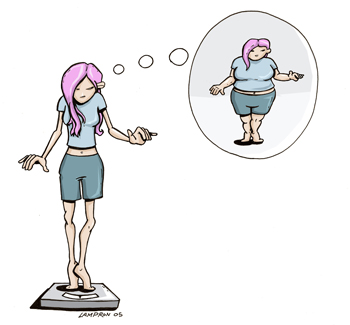
According to the Healthy Eating Pyramid, exercise and weight control is the basis of the pyramid because a healthy weight is obtained by maintaining a normal weight through healthy eating and daily exercise. Whole grains, healthy fats and oils, and vegetables and fruits are the level above exercise in the pyramid. The body needs carbohydrates mostly for energy. The best sources of carbohydrates can be found in whole grains such as oatmeal, whole wheat bread, and brown rice. Whole grains cannot be processed quickly by the body, which keeps blood sugar and insulin levels from rising, then falling, too quickly. Better control over blood sugar and insulin can keep hunger under control and prevents the development of type 2 diabetes. It can also help prevent heart disease. Healthy fats and oils include healthy unsaturated fats such as olive oil, canola oil, soy oil, corn oil, sunflower oil, peanut oil, and other vegetable oils, trans fat-free margarines, nuts, seeds, avocados, and fatty fish such as salmon. These healthy fats help improve cholesterol levels when eaten in place of highly processed carbohydrates, but can also protect the heart from sudden and potentially deadly rhythm problems. Eating plenty of fruits and vegetables has great benefits. It can decrease the chances of having a heart attack or stroke, possibly protect against some types of cancers, lower blood pressure, help prevent diverticulitis, and guard against cataract and macular degeneration.
On the Healthy Food Pyramid, a level above the fruits and vegetables, nuts, seeds, beans, and Tofu, as well as fish, poultry, and eggs are described. Nuts, seeds, beans, and Tofu are plant foods that are excellent sources of protein, fiber, vitamins, and minerals. Various beans are included that are typically sold dried. Many types of nuts contain healthy fats in variety packs, and they can also be good for your heart. Fish, poultry, and eggs are important sources of protein. Eating fish can help to reduce the risk of heart disease. Chicken and turkey are also good sources of protein and can be low in saturated fat. Eggs, which contain fairly high levels of cholesterol, are not so bad. An egg for breakfast is much better than a doughnut or bagel. People with diabetes or heart disease, however, should limit their egg yolk consumption to no more than 3 a week. Egg whites, however, are very high in protein.

A level above eggs on the pyramid is dairy products, typically 1 to 2 servings per day, or vitamin D or calcium supplements. Calcium, vitamin D, exercise, and much more contribute to building bone and keeping bones strong. Dairy products contain much calcium and vitamin D, which are important for health. Milk and cheese are not the healthiest ways to obtain calcium and vitamin D because of saturated fat. Low-fat or no-fat products are best to be consumed.
The top of the pyramid contains red meat, processed meat, and butter, as well as refined grains such as white bread, rice, and pasta, potatoes, sugary drinks and sweets, and salt. These items should be consumed sparingly. Red and processed meats and butter contain much saturated fat and added sodium, which are linked to increased risk of heart disease, diabetes, and colon cancer. Refined grains, potatoes, sugary products, and salt can cause fast increases in blood sugar that can lead to weight gain, diabetes, heart disease, and other chronic disorders. All these different levels of the pyramid are created to show people the right portions and types of food products that are best to eat daily and what else is essential for a healthy lifestyle.
 Various exercises are great for maintaining a healthy weight, building muscle, and losing any unwanted fat. It is important to stay active daily through sports, going to the gym, working out at home, walking, or participating in other physical activities. In order to lose weight, one must burn more calories than one consumes. Adults should get two and a half hours of aerobic exercise each week. The exercises should be spaced out and last at least ten minutes at a time. Find ways to increase daily activity in order to achieve a healthy weight. Walk more often, climb stairs, and do various household activities.
Various exercises are great for maintaining a healthy weight, building muscle, and losing any unwanted fat. It is important to stay active daily through sports, going to the gym, working out at home, walking, or participating in other physical activities. In order to lose weight, one must burn more calories than one consumes. Adults should get two and a half hours of aerobic exercise each week. The exercises should be spaced out and last at least ten minutes at a time. Find ways to increase daily activity in order to achieve a healthy weight. Walk more often, climb stairs, and do various household activities. 






